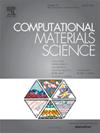Calculation of the critical nucleus size and minimum energy path of T3 phase in Fe-Mn-Ni-Si alloys: An integrated phase-field and constrained string method
IF 3.1
3区 材料科学
Q2 MATERIALS SCIENCE, MULTIDISCIPLINARY
引用次数: 0
Abstract
Manganese-Nickel-Silicon Precipitate (MNSP) phase (T3) significantly influences the properties of Fe-Mn-Ni-Si quaternary alloys, particularly for potential applications in irradiation environments. Understanding the nucleation thermodynamics and kinetics of this specific phase is therefore crucial for predicting microstructure evolution. In this work, a phase-field model coupled with constrained string method was employed to investigate the minimum energy path (MEP) for T3 phase and to characterize the energy barrier, size, and elemental composition of the T3 critical nucleus under the consideration of an irradiation-enhanced diffusion mechanism, as affected by temperature, initial silicon concentration effects. The chemical free energies used in the model were derived from the thermodynamic database of Fe-Mn-Ni-Si system. Simulations reveal that the formation of the T3 phase requires overcoming a distinct nucleation energy barrier, which varies strongly with both temperature and initial alloy composition. Specifically, the nucleation energy barrier increases significantly with increasing temperature but decreases with increasing initial silicon concentration in the alloy. Analysis of the critical nucleus reveals that its size generally expands with rising temperature. Separately, the average concentrations of Mn and Ni within the nucleus also increase with temperature, while showing a complex dependence on the initial alloy composition. The findings highlight the complex interplay of thermodynamic driving forces and kinetic factors governing T3 nucleation in this multi-component system and provide quantitative insights valuable for guiding alloy design and predicting microstructural evolution, especially under irradiation conditions.

Fe-Mn-Ni-Si合金中T3相临界核尺寸和最小能量路径的计算:集成相场和约束弦法
锰-镍-硅沉淀(MNSP)相(T3)显著影响Fe-Mn-Ni-Si四元合金的性能,特别是在辐照环境中的潜在应用。因此,了解这一特定相的成核热力学和动力学对于预测微观结构演变至关重要。本文采用相场模型结合约束串法研究了T3相的最小能量路径(MEP),并表征了在辐射增强扩散机制下,受温度、初始硅浓度效应影响的T3临界核的能垒、尺寸和元素组成。模型中使用的化学自由能来源于Fe-Mn-Ni-Si体系的热力学数据库。模拟结果表明,T3相的形成需要克服明显的成核能势垒,该势垒随温度和合金初始成分的变化强烈。随着温度的升高,成核能势垒显著增加,但随着合金中初始硅浓度的增加而降低。对临界核的分析表明,它的大小一般随着温度的升高而增大。另外,核内Mn和Ni的平均浓度也随着温度的升高而升高,同时与初始合金成分表现出复杂的依赖性。这些发现强调了在这个多组分体系中控制T3成核的热力学驱动力和动力学因素的复杂相互作用,并为指导合金设计和预测微观组织演变提供了有价值的定量见解,特别是在辐照条件下。
本文章由计算机程序翻译,如有差异,请以英文原文为准。
求助全文
约1分钟内获得全文
求助全文
来源期刊

Computational Materials Science
工程技术-材料科学:综合
CiteScore
6.50
自引率
6.10%
发文量
665
审稿时长
26 days
期刊介绍:
The goal of Computational Materials Science is to report on results that provide new or unique insights into, or significantly expand our understanding of, the properties of materials or phenomena associated with their design, synthesis, processing, characterization, and utilization. To be relevant to the journal, the results should be applied or applicable to specific material systems that are discussed within the submission.
 求助内容:
求助内容: 应助结果提醒方式:
应助结果提醒方式:


